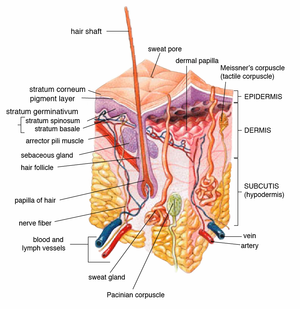http://en.wikipedia.org/wiki/Exfoliation_(cosmetology)
Exfoliation (cosmetology)
From Wikipedia, the free encyclopedia
This article is about the cosmetic technique. For other uses, see Exfoliation (disambiguation).
| This article needs more medical references for verification or relies too heavily on primary sources. (February 2013) |
Exfoliation involves the removal of the oldest dead skin cells on the skin's outermost surface, and has been used for many years to help maintain healthy skin. Exfoliation is involved in the process of all facials, during microdermabrasion or chemical peels at medical spas. Exfoliation can be achieved through mechanical or chemical means.[1]
Contents
[hide]History[edit]
Credit is given to the ancient Egyptians for the practice of exfoliation.[2] In the Middle Ages, wine was used as a chemical exfoliant, with tartaric acid as the active agent.[2] InAsia, the practice of exfoliation started hundreds of years ago.[3] The etymology of the word exfoliate comes from the Latin exfoliare (to strip off leaves).[4]
Importance[edit]
Main article: Skin care
New skin cells are created in the skin's lower layer, the dermis. Over time, cells migrate to the surface of the skin and become more acidic. During their 30-day journey, they die and become saturated with keratin. Keratin is important because it protects the skin from outside elements. Through the ageing process, and after menopause for women, the natural process of skin erosion becomes uneven, which gives skin a dry and rough character. Exfoliation removes the outer layer to reveal the newer skin beneath. This shedding of the outer layer unclogs pores, keeps skin clean, and helps reduce acne outbreaks. Exfoliation should always be done after cleansing the skin.[citation needed] Exfoliation is important for men as it exposes the hair follicles, allowing a better shave. It is possible to over exfoliate, which dries and irritates the skin. The face is the part of the body most sensitive to exfoliation.[5] Hence, provided that exfoliating causes the skin to dry out, it is very important to moisturize it, because dry skin can lead to wrinkledevelopment[citation needed].
Types[edit]
Exfoliation is achieved through either mechanical or chemical means.
Mechanical[edit]
This process involves physically scrubbing the skin with an abrasive.[5] Mechanical exfoliants include microfiber cloths, adhesive exfoliation sheets, micro-bead facial scrubs, crepe paper, crushed apricot kernel or almond shells, sugar or salt crystals, pumice, and abrasive materials such as sponges, loofahs, brushes, and simply fingernails.[6][7] Facial scrubs are available in over-the-counter products for application by the user. People with dry skin should avoid exfoliants which include a significant portion of pumice, or crushed volcanic rock. Pumice is considered a good material to exfoliate the skin of the feet.[8][dead link] Microdermabrasion is another mechanical method of exfoliation.
Chemical[edit]
Chemical exfoliants include scrubs containing salicylic acid, glycolic acid, fruit enzymes, citric acid, or malic acid which may be applied in high concentrations by a medical professional, or in lower concentrations in over-the-counter products. Chemical exfoliation may involve the use of products that contain alpha hydroxy acids (AHAs), beta hydroxy acids (BHAs), or enzymes that act to loosen the glue-like substance that holds the cells together, allowing them to ease away.[5] This type of exfoliation is recommended for people treating acne.[9] In beauty spa treatment on continental Europe, the chemical properties of wine producing grapes are exploited in the practice of vinotherapy which is becoming increasingly popular.[citation needed]
With hair removal[edit]
Some methods of hair removal also exfoliate the skin.
- Waxing is a mechanical process which is done with the intention of plucking the hair, which also functions as a mechanical exfoliant. As this is done every two to eight weeks, it is not performed as frequently as many exfoliate, so it does not fully substitute for a regimen, but may substitute for a normal session in a regimen.
- Nair is an example of a chemical hair removal product which also functions as a chemical exfoliant. It is done more frequently than waxing (once a week rather than once a month) since it only destroys hair partially below the skin, rather than destroying the entire root as with waxing. Using it weekly can substitute for a weekly exfoliant regime. It is a very aggressive chemical and cannot be used on the face so other exfoliants would need to be used on the face.
- Wetshaving also has exfoliating properties; first, the action of moving a shaving brush vigorously across the face washes the face and removes dead skin at the same time. After applying the lather with a brush, the use of a double-edged safety razor or straight razor removes dead skin simply by the fact that the aforementioned razors are dragged much closer across the skin and remove dead skin more effectively than a cartridge or electric razor.
Promotion[edit]
In popular media, exfoliants are advertised as treatments which promote beauty, youthful appearance, or health.[6]
Disadvantages[edit]
One disadvantage to exfoliation is the high price of some of the products and methods used to achieve it. Exfoliation will lead to some initial redness to the skin. Near the end of chemical peels, the skin will frost, with colors varying from a bright white to grey on the skin surface.[2]
See also[edit]
References[edit]
- ^ Joe Ball. New Skin - Via Exfoliation. Retrieved on 2008-03-03.
- ^ a b c Raymond T Kuwahara, MD. HISTORY OF CHEMOEXFOLIATION. Retrieved on 2008-03-03.
- ^ Dr. Rock Positano. Getting Under Your Skin. Retrieved on 2008-03-03.
- ^ http://www.merriam-webster.com/dictionary/exfoliation
- ^ a b c Anitra Brown. What is Exfoliation? Retrieved on 2008-03-03.
- ^ a b Alex Muniz. Exfoliation: The Secret To Healthy Skin. Retrieved on 2008-03-03.
- ^ Cathy Wong. How to Give Yourself a Dry Brush Exfoliation. Retrieved on 2008-03-03.
- ^ Dr. John Gray. The World of Skin Care. Retrieved on 2008-03-03.
- ^ Wdxcyber.com. Facial Skin Exfoliation. Retrieved on 2008-03-03.




No comments:
Post a Comment